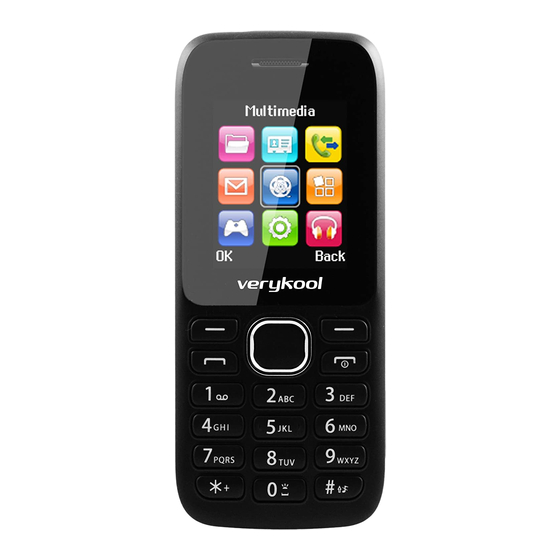
Table of Contents
Advertisement
Quick Links
Advertisement
Table of Contents

Summary of Contents for Verykool 1211
- Page 1 Verykool i1211 User Manual...
- Page 2 © 2014. All rights are reserved. No part of this document may be reproduced without permission. While all efforts have been made to ensure the accuracy of all the contents in this manual, we assume no liability for errors or omissions or statements of any kind in this manual, whether such errors or omissions or statements resulting from negligence, accidents, or any other cause.
-
Page 3: For Your Safety
1. For your safety Read this simple guideline. Not following them may be dangerous or illegal. Read the complete user manual for further information. Do not switch your phone on when the use of wireless devices is prohibited or when the wireless device may cause interference or danger. Do not use your phone while driving. -
Page 4: Phone Overview
2. Phone Overview 2.1 Appearance Center key Ending/Power key Left soft key Keypad Dial/Answer key Microphone Earpiece Charge/Headset port Display Camera Navigation key Speaker Right soft key Torch... - Page 5 2.2 Keypad Definition Definitions 1. Execute functions that the left-down/right-down corner indicator shows. Left Soft key/ 2. In the standby mode, press left soft key to enter main Right Soft key menu , press right soft key to access Contacts. 1.
-
Page 6: Getting Started
3. Getting started 3.1 Installing the SIM Cards, T-flash card and battery. 1) Remove the back cover and lift the battery away. 2) Insert the SIM card into the SIM card slot lightly with the corner cutting of the card aligning to the notch of the slot and the gold plate of the card facing downward, till it cannot be pushed further in. - Page 7 3.2 Charging the Battery The lithium battery delivered with the mobile phone can be put into use immediately after being unpacked. Battery level indication: Your mobile phone can monitor and display the battery state. Normally the remaining energy of the battery is indicated by the battery level icon at the upper right corner of the display screen.
-
Page 8: Input Methods
3.3 Powering On/Off the Mobile Phone Hold the End key for a while to power on the mobile phone. A power-on animation appears on the display screen. Input the phone lock code and press the OK key if the mobile phone prompts you to input the phone lock code. -
Page 9: Using The Menus
5. Using the Menus 5.1 File Manager The phone supports the T-Flash card. You can use the file manager to conveniently manage various directories and files on the T-Flash card. 5.2 Contacts The mobile phone can store at least 300 phone numbers. 5.3 Call logs Through this function, you can view a list of missed calls, dialed calls and received calls 、rejected calls etc. - Page 10 Calendar Once you enter this menu, there is a monthly-view calendar for you to view the date; you can go to any day you want. Alarm You can activate one, or multiple as needed. For each alarm clock, the ringing date and the ringing time can be set.
- Page 11 you entered. 4) Auto keypad lock:After activating this function, the phone will be locked automatically after a particular time, so as to avoid error operations 5) Guardlock: You can activate or deactivate the guardlock function, When the guardlock is activate, once your SIM card is replaced, the phone will automatically send stolen information to the prior SIM card.
-
Page 12: Common Fault Diagnosis
6. Common fault diagnosis Fault phenomenon possible reasons Cannot turn on The battery is discharged. Charge it with electricity. SIM card smudgy, clean the SIM card. Reinstall the SIM Wrong SIM Card card. SIM card has been damaged, replace the SIM card。 Check on the screen of the signal strength indicator, and Reception bad this is the number of symbols in this for 5 case said the... -
Page 13: Fcc Caution
7. FCC Caution 7.1 Labelling requirements. This device complies with part 15 of the FCC Rules. Operation is subject to the following two conditions: (1) This device may not cause harmful interference, and (2) this device must accept any interference received, including interference that may cause undesired operation.














